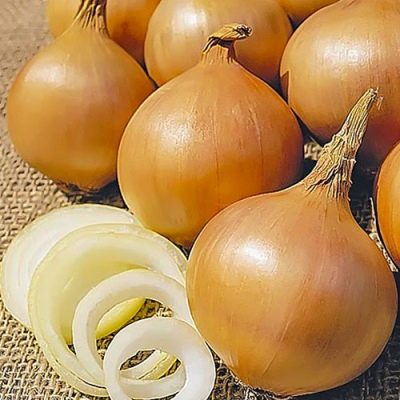
- Authors: Dubova M.V., Florova V.A., Agafonov A.V., Efimova E.G.
- Year of approval: 2011
- Ripening terms: mid-season
- Bulb weight, g: 60-70
- The form: rounded
- Dry scales: yellow
- Coloring juicy scales: white
- Density: dense
- Taste: spicy
- Appointment: salad, for fresh consumption, for canning
It is not difficult to grow onions in a garden bed if you choose a non-capricious variety that quickly adapts to the climatic features of the growing region. For the Central region, the mid-season onion variety Kolobok, bred by Russian scientists, is suitable.
Breeding history
Onion Kolobok is a relatively new variety, bred on the basis of the Federal Research Center of Vegetable Growing in 2008. The authorship belongs to several breeders: Agafonov A.V., Efimova E.G., Dubova M.V. and Florova V.A. The most productive variety when grown in the Central region. Onions are grown mainly in the open field.
Description of the variety
Vegetable culture Kolobok is a compact plant with an erect rosette of feathers. Onion feathers are characterized by a bright green color, moderate thickening, average height (30-40 cm), as well as a rare formation of arrows during the growing season.
Characteristics of the appearance of plants and bulbs
The gingerbread man stands out among its relatives with an attractive presentation. Onion specimens ripen neat. The variety belongs to the medium-fruited species. The average bulb weight is 60-70 grams. The shape of the root crops is round, with a neck of medium thickness. The surface of the bulbs is firm, perfectly smooth, shiny, consisting of 4 dry scales of a uniform yellowish-golden color. Onion pulp has a snow-white color and high density. The structure of the onion is medium-sized, including 2-3 bulbs.
The harvested crop tolerates transportation without significant losses, and also has good keeping quality - up to 7-8 months at a temperature of + 2-5 degrees in a ventilated container.
Purpose and taste
The taste of the vegetable is good, pronounced. The snow-white pulp is endowed with moderate density, meatiness, juiciness and light crunch. The taste of the vegetable is balanced, spicy, with hints of piquancy and light pungency. In addition, onion pulp is rich in vitamins, minerals, amino acids.
The dug out bulbs are added to fresh salads, cold and hot dishes, pickled, used in canning vegetables, and also grown for harvesting for the winter. In addition, this variety, according to nutritionists, has bactericidal and anti-sclerotic properties.
Maturation
The gingerbread man represents a class of mid-season vegetables. From the moment of emergence of mass shoots to mature bulbs on the ridges, it takes 100-110 days. Vegetables ripen at different times, so the harvest period is somewhat extended. You can start digging a vegetable in late July or early August.
Yield
This species is quite productive. With proper agricultural technology, from 1 m2 of plantings, you can dig up from 3 to 5 kg of juicy fruits. In a favorable environment, yields can reach 8.5-9 kg / m2. On an industrial scale, the yield is also high - 292-416 kg / ha.
Planting dates with seeds, seedlings and seedlings
Sowing seeds for seedlings is performed in March, and transplanting to a permanent place of growth is carried out in the first half of May. Sevok is planted in open ground in mid-May, sometimes at the end of April, if weather conditions permit.
Growing and care
Onions are cultivated both in seedlings and sevkom. When growing through seedlings, seeds are sown, which are pre-disinfected and treated with growth stimulants.To accelerate germination, you can apply the greenhouse effect. A transfer to a garden bed is performed during a period when the air is warmed up to + 12-14 degrees.
If you grow with sevkom, then you need to select high-quality bulbs without damage and foreign smell, prepare a site with grooves 2.5-3 cm deep.The planting is carried out according to the 20x10 cm scheme.Good predecessors for onions are tomatoes, potatoes, cucumbers, cabbage and legumes culture.
The agricultural technology of vegetable crops includes watering every 7-10 days (they stop 2-3 weeks before harvesting), fertilizing three times per season (nitrogen and organic-mineral complexes), weeding and loosening, prevention of diseases and pests. In addition, do not forget about light mulching using straw, sawdust and hay.

Since the onion is an unpretentious and cold-resistant plant, it can be planted both in spring and autumn. It is necessary to properly prepare the planting material, competently prepare the garden bed and determine the timing of planting.

Soil requirements
Onions are planted in light, fluffy, fertile, breathable and non-acidic soil. Experts recommend planting on a small hill, on light loamy and sandy loam soils.

The bow is not as unpretentious as it seems. For good growth, you need fertile soil, quality care and nutritious fertilizers. Without top dressing, the bulbs will grow small, and the greens will not be lush. At different stages, it should be fed with different substances. The vegetable needs organic and mineral feeding. A good result for fertilizing onions is the use of folk remedies.
Required climatic conditions
Despite its good stress resistance, a vegetable crop needs a sunny area, where it is warm, light, and there is a barrier from drafts. Do not plant onions in lowlands and waterlogged soils.
Disease and pest resistance
Due to its strong immunity, the culture is rarely exposed to fungal diseases, infections inherent in onion varieties (downy mildew, fusarium, rot). In addition, the plant is rarely attacked by pests (onion fly).

Despite the fact that the onion is a very useful plant, capable of repelling and killing many microbes and bacteria, it itself is often damaged and suffers from various misfortunes. Diseases and pests of onions can significantly reduce the yield. It is necessary to correctly determine the presence of this or that disease and take appropriate measures in time.


















































































